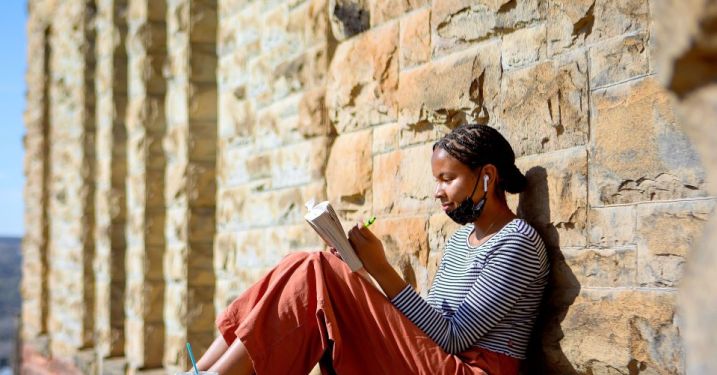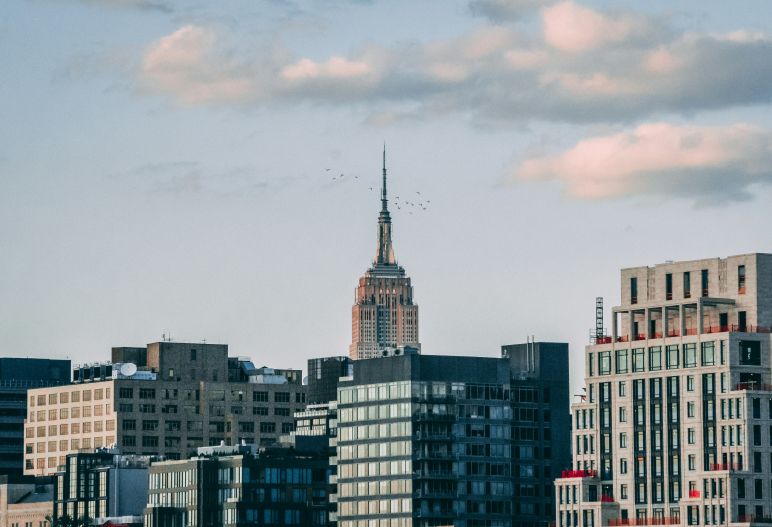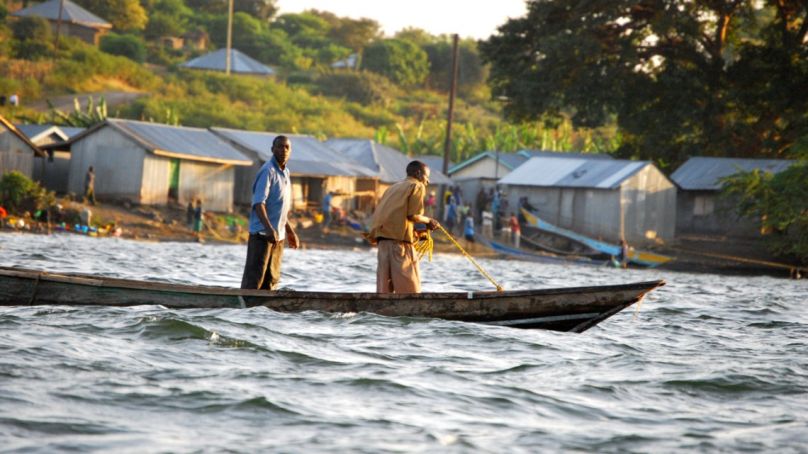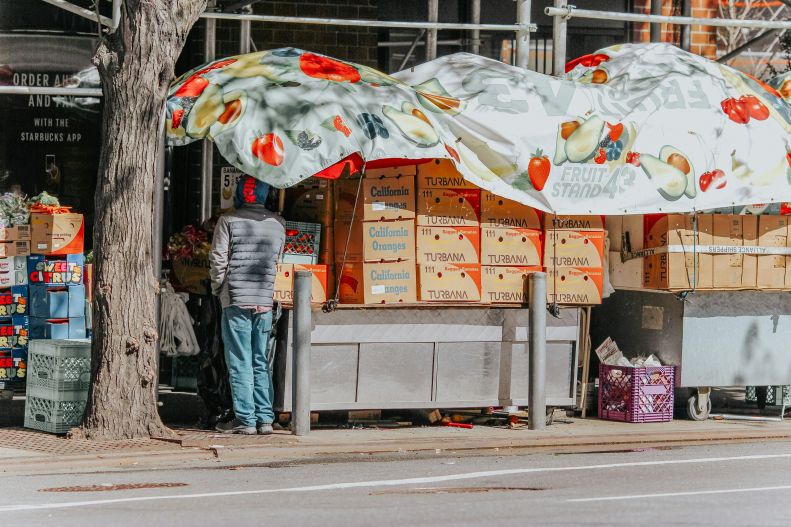Migrations Program
Creative Competition Winners Share Stories of Migration

How does migration shape life in your community? Our students and staff responded with their art and writing in this year's creative competition.
Table of Contents
- “Naturalization Test” and “Immigrant React” by Aishvarya Arora
- Itha-Kaoua by Shirley Le Penne
- "Coexistence: A Reflection on Migration" by Wanlu Liu
- "Of the Fruit Tree" by Yazmin Muniz
- "A Place to Roost" by Audrey Pinard
- "En Comunidad” by Liz Radman
Naturalization Test and Immigrant React
By Aishvarya Arora, MFA candidate in poetry
Read the poems in their original format: “Naturalization Test” and “Immigrant React.”
Itha-Kaoua
By Shirley Le Penne, PhD candidate in government
Coexistence: A Reflection on Migration
By Wanlu Liu, MA student in architecture
Migration is a cycle of survival, transformation, and adaptation. Coexistence explores this continuous movement through the interplay of predator and prey, human and nature, struggle and resilience. The piece blurs these boundaries, illustrating how migration is not just a human experience but a fundamental force that shapes all life.
The tension between predator and prey mirrors the challenges faced by those who migrate—some driven by necessity, others by pursuit, all caught within a larger system of displacement and renewal. The intricate patterns weaving through the composition represent the unseen forces that connect and divide us—borders, histories, and the shifting landscapes of identity.
In my community, migration shapes not only who we are but how we coexist. This piece invites reflection on the ways we navigate spaces of belonging, conflict, and transformation, all within a cycle that extends beyond humanity into the broader rhythms of the natural world.
Of the Fruit Tree
By Yazmin Muñiz ’27, English and government
Read “Of the Fruit Tree” in its original format.
Artist's Statement
Like all things, there's always a root—cause, action, belief. There's always a bigger picture, and in turn a bigger story to be told. Migration is just that. It's a root for many of us, including myself. I wanted to tell the story of migrations past through language, which is often associated with the word "root."
Language tells the story of migration without needing to actually story tell by the books. A person does not need to understand a foreign language to grasp a story of change, a person can look towards the structures that compose something or even someone. My poem tells migration through a tree-shaped poem and the following languages: Spanish (Puerto Rican, Colombian, and Spanish dialects), English, Portuguese, Arabic (Moroccan Darija Dialect), Yoruba, and Borinken Taino.
The left side of the tree details the migration of my maternal family tree, where three Portuguese brothers sailed to Brazil and then to the Colombian northern coast to live there. It then follows the Spanish migration, and the unions in my maternal side to become mixed with the dialects, languages, and different races in the area.
On the right-hand side I discuss my paternal lineage, which hails from Puerto Rico. I decided to write in the Taino language which is still very limited as most was lost to the colonial era. That particular segment details the self-perception of the Tainos and their perceptions of the Spanish conquistadors. No migration happens on the part of the Tainos, but they do witness it—and like everyone they have their beliefs on it.
The next part follows a Puerto Rican, who again does not physically migrate. Instead, they have to migrate through the different shifts of power from the Spanish to the Americans. The shift in language towards the end of that segment contains English words, amplifying the language shift as the government migrated.
The end of the poem is in English, it represents where my immediate family have immigrated to, and where I am as a first-generation American. I'm now surrounded by English and by a constant search for my roots even though I know them already. This idea was actually born that way. It might seem a bit funny, but ever since I was a kid I was always searching up the names of grandparents in the Colombian or Spanish military archives to see who came before them.
I just did not want to pay for Ancestry DNA. Now, over a decade later I decided to bite the bullet and do that DNA test. I found I'm Portuguese, Western African, Moroccan, Palestinian, European Jewish, Indigenous Colombian, and Puerto Rican, Spanish from the Canary Islands, Basque—you name it. I thought I would be satisfied seeing the numbers, but I was in fact NOT satisfied. I realized I was more interested in the stories of how my ancestors got to this point in the United States. I knew I couldn't get the answers anymore, as these stories die with our loved ones. However, it was left to the imagination and so this piece was born. So, I think of migration as a transitory measure that connects me to my ancestors, people that don't know me and I don't know. It's the vector for my storytelling and imagination, and it's a reminder there is always a 'root' or a beginning.
Just like the fruit tree, it symbolizes the beginning of life, of a story, and of transition—through seasons distant or near.
A Place to Roost
By Audrey Pinard ’25, Earth and atmospheric sciences
Before I ever thought of marriage, I had to be a father.
I used to think mine was selfish—leaving me at eighteen with a mother and two sisters to care for. It wasn’t his fault he died, but at that age, it felt that way.
Most kids I knew ended up where their parents did—in the Army or the Navy. That’s what happens when you grow up on a U.S. military base. Life happens in cycles. People eat, live, and die, all in the same place. Families packed up and left, replaced by new ones before the dust even settled. But we never moved. My father’s death secured us a home.
But I couldn’t stay.
I was old enough to be drafted, and South Korean policy meant twenty months in service. If I enlisted, my mother would be alone, raising my sisters without a degree or a job. Sure, we had a death gratuity check, but it wasn’t enough. And I wasn’t enough—not yet. So, I left for America.
San Francisco wasn’t kind at first. Even with a belt, my pants sagged under the weight of quarters from my laundromat job. The scent of lavender detergent clung to me like secondhand smoke. By day, I took classes. By night, I cleaned lint traps, folded strangers’ clothes, and counted my coins, all while living on my friend’s couch, waiting for California residency to kick in.
One afternoon, a few of us—Daniel, Oliver, Jamie, and Chris, all guys from Yongsan—found ourselves hungry and broke. Jamie had a solution. His family owned a chicken farm in Petaluma. He said we could have two birds for free—if we caught and cooked them ourselves.
It was exciting at first.
The chickens hopelessly flapped their wings and clucked as Oliver and I chased them with our eager hands stretched out. They nipped our palms as we attempted to lure them with feed. Then one chicken fell victim. Daniel grabbed its feet, flipped it upside down, and handed it to me enthusiastically. I smiled back nervously.
He and Chris went to find some booze, leaving me alone in an ash-marked house. A feeble light flickered overhead, casting misshapen shadows across the tainted cedar walls.
I knew what to do.
Jamie said it was a simple twist and snap. The instructions were comprehensible and easy to follow, yet seemed unnatural. The chicken wouldn’t feel a thing.
I tried to convince myself of that as it began to thrash violently.
I clenched my teeth, pressing my fingers harder into its scaly legs. Its frantic squawking filled the room, clawing at the silence like a child screaming in rebellion. My grip tightened around its neck, my thumb tracing the fragile dip in its throat. The moment stretched longer than I expected—longer than I could bear.
I twisted.
A sharp crack rang out. Its wings convulsed, slamming against my chest. Its claws, still slick from the dirt outside, raked my wrist, desperate to find something solid in a world that had just betrayed it. I held firm, but my stomach churned. Its body trembled in short, uneven spasms, every nerve firing its last protest.
Then, finally, it stilled.
I swallowed hard and carried it to the boiling pot of water in the corner of the room. When I submerged it, the stench hit me all at once.
Wet feathers. Damp flesh. Singed rubber.
The steam curled against my face, pushing into my nostrils and coating my tongue. I gagged, searching for a window, but they were nailed shut. The air thickened around me, suffocating.
I yanked the chicken out, laid it on the wooden block in the center of the room, and hesitated before touching it again. My eyes were welling with tears, and I told myself it was from the searing sting of sulfur.
I plucked its matted wet feathers—cautiously at first, like I was afraid I’d somehow still hurt it. They fell in clumps to the floor, unsettling the dust-covered ones beneath them. I picked faster, more vigorously, until I was practically ripping them off, my fingers raw from the effort.
The bloated, goosebump-covered skin started to show.
It was naked. Vulnerable. Diminishing with every pluck into something unrecognizable.
If anyone else had seen it, they would have thought it was store-bought, neatly prepped to enjoy. All that was missing was air-tight plastic wrap and a brand name slapped on the front so that it’d appear desirable.
Once clean of the remaining dirt, I sliced off the head, liquid crimson splattering across my Converse All Stars. I squeezed my hand through the gaping hole between its shoulders and separated its organs from its heart.
I hesitated, reluctant to toss its feet aside, but Americans do not eat that part.
Splayed out in front of me, the mangled carcass lay paralyzed: broken, stolen from its kind, and stripped of its voice.
Plucked of its characteristics, it was left to be a hollowed-out shell, consisting of only parts of value.
I never went back to the farm.
But I carried it with me.
Forty years later, I’ve almost forgotten that night. Almost.
I built a life here. I got my degree at Berkeley. I sent my sisters to Washington Middle School so they could get the education they deserved. They did well, but they also learned what it meant to be foreign, to be seen as something other.
We assimilated the best we could. Dressed like them, spoke like them, ate like them. Yet, in the end, it didn’t matter.
I had an appetite for the American dream and let it consume me, even as I knew it was empty.
Every now and then, when I make chicken noodle soup for my loved ones, the sickening stench of wet feathers drifts through the air, and I remember that night in a language I’ve nearly lost.
They say that home is where you make it, but sometimes, I wonder—if you leave too much behind, do you ever truly find a place to roost?
En Comunidad
By Liz Radman, Assistant director of engineering advising in the College of Engineering
This wood carving is not just art, it’s a reflection of how migration shapes my very own life and community. I grew up in a household shaped by creativity and adaptation. My father immigrated to the U.S. as a child from the former Yugoslavia (now Croatia), while my mother was born and raised in the U.S. My spouse also came to the U.S. as a child from Mexico. Our stories, like so many others, are woven together by migration, resilience, and reinvention which is mirrored in this piece.
The wood I used was reclaimed from another project. It was an opportunity to give it a new life—similar to the story told in my house growing up, hearing about my father’s family having to make and imagine a new life and new possibilities. Growing up in an immigrant home means seeing the potential everywhere, not just in objects, but people, places, concepts, and futures. Planting seeds and nurturing them takes patience, especially when the garden must be reimagined over and over again, or when those who planted the seeds never get to see what takes root.
Within the actual image is an outline of Mexico, my spouse's homeland before coming to the U.S. Above it is a butterfly—a universal symbol of transformation and migration. The embodiment of immigration hovers. Surrounding the edges of the wood are plants of all types scattered sporadically along with seeds. This represents that no matter how we grow or where we land, as long as we tend and support one another, we can grow. This piece showcases that migration is not just about movement across the globe, it is about the movement of shaping the world around us. It is both art and a part of our lives.
The medium for this was wood burning—a skill I taught myself. Beyond the crude technique, this process holds meaning. As the wood burns, it releases scent, and smoke rises—an undeniable transformation. The immigrant story is often oversimplified or romanticized, but working with heat as a medium reminded me that the reality for those who travel here is that they are forged. Burning is unforgivable. One mistake can erase hours of careful work. This felt a fitting parallel to the unfairly high standards placed on immigrants in the U.S., where travelers are expected to embody the “perfect immigrant” stereotype, despite the incredibly different treatment they will experience based on background, skin color, language, and other intersectional parts of themselves.
If I had used paint—my typical medium—I would have been able to cover or hide any mistakes I made and have multiple chances to fix errors in the design. But wood burning felt like the right choice for this particular prompt and project. This piece carries intention and time, and is a raw, unfiltered reflection of that deliberate existence that some may not understand. It is the result of teaching oneself a skill when no teacher is around. The immigrants who have crossed my path have always served as both teachers and students in every space I have ever been in, and I am eager to learn from their stories and listen.
What I love most about this piece is that it has lived many lives already. It holds both a functional and symbolic place in our home—holding warm mugs of cafecito, supporting fresh palachinka from a hot pan, or acting as a plate for galletas between bites. At times this artwork rests on our mantel, reflecting changing seasons. During Día de los Muertos, it always finds a place on our ofrenda, honoring loved ones near and far from all roots of our family tree—or better yet, our family garden that has grown and now spreads across the globe. It is a quiet yet sturdy display of how we as a family create, adapt, and take pride in our cultures and one another as it not only decorates our home, but is actively a part of our everyday lives. My family, my community, has only ever been shaped and continued to grow out of migration.
Additional Information
Program
Creative Writing and Art Competition

How does migration shape life in your community? Submit your essays, poetry, and art to our creative writing and art competition.
Eric Tagliacozzo

Director, Southeast Asia Program
Eric Tagliacozzo is the John Stambaugh Professor of History at Cornell University. He is the director of the Einaudi Center's Southeast Asia Program, and a core faculty member of the Southeast Asia Program and South Asia Program.
His research centers on the history of people, ideas, and material in motion in and around Southeast Asia, especially in the late colonial age.
Geographic Research Area: Southeast Asia, South Asia
Teaching/Research Interests: Migration and trade, material history, Silk Road, Indian Ocean
Additional Information
Program
Role
- Faculty
- SAP Core Faculty
- SEAP Core Faculty
- SEAP Director
- Einaudi Faculty Leadership
- Executive Committee
Contact
Email: et54@cornell.edu
Protecting the Rainforests of Mesoamerica so We Can Keep Watching Migratory Birds in Central Park

Cornell Researchers Contribute to Study
Researchers from Cornell University contributed to a study tracking migratory birds between North America and Mesoamerica using the eBird platform.
Additional Information
Fish Farming is Booming in Lake Victoria, But Pollution and Disease are Wiping Out Millions

Katie Fiorella, Migrations Director
According to Migrations director Katie Fiorella, Lake Victoria's aquaculture industry holds promise for improving food security and livelihoods in east Africa.
Additional Information
World in Focus: Gaza–Israel Conflict: Regional and International Impacts

November 11, 2025
4:00 pm
Uris Hall, G08
Join Einaudi Center experts for World in Focus Talks on global events in the news and on your mind. Our faculty's research and policy insights put the world in focus.
This year we’re hosting informal campus discussions on many Tuesday afternoons. This week’s topic:
The Gaza–Israel conflict escalated dramatically in October 2023, following Hamas's attack on Israel and Israel's subsequent military campaign in Gaza. After intense fighting that caused massive Palestinian casualties and displacement, a ceasefire and the outline of a peace agreement have been announced. These events will have far-reaching consequences for the region and the world: heightening political and security tensions in the Middle East, disrupting international humanitarian and legal systems, and straining international relations.
How is the Gaza–Israel conflict transforming the Middle East and challenging the international order?
***
Featured Speakers
Sandra Babcock (SEAP) | Law SchoolAlexandra Blackman (SWANA) | GovernmentEsam Boraey (PACS, Migrations) | GovernmentPeter Katzenstein (IES, PACS) | GovernmentJoseph Margulies (PACS) | GovernmentJake Silver | Near Eastern StudiesChantal Thomas (IAD) | Law School
***
Conversations Matter at Einaudi
This conversation is hosted by the Mario Einaudi Center for International Studies and its regional and thematic programs. Find out what's in store for students at Einaudi!
Additional Information
Program
Einaudi Center for International Studies
Reppy Institute for Peace and Conflict Studies
East Asia Program
Southeast Asia Program
Latin American and Caribbean Studies
Institute for African Development
Institute for European Studies
South Asia Program
Migrations Program
Southwest Asia and North Africa Program
Einaudi Kicks Off Yearlong Conversation on Foreign Aid
Lund Debate 2025
Undergraduate Global Scholars joined debaters to discuss “Is (Cutting) International Aid Good?”
For decades, international aid mainly flew under the radar of public opinion. Politicians from across the ideological spectrum lauded programs that saved lives, nurtured democracy, and promoted American values and interests. Except during wars and natural disasters, aid was rarely in the news.
That changed on January 20, 2025, when President Donald J. Trump issued an Inauguration Day executive order freezing all U.S. foreign assistance. Within weeks, Secretary of State Marco Rubio closed the headquarters of the U.S. Agency for International Development (USAID) and canceled 83% of the agency’s programs. Suddenly, foreign aid was at the center of an intense debate over national priorities and America’s place in the world.
January 20 was also the day that political scientist Ellen Lust arrived at Cornell to direct the Mario Einaudi Center for International Studies as the John S. Knight Professor of International Studies. One of her first actions was selecting a theme to guide the center’s programming and provide a focus for its Undergraduate Global Scholars for the 2025–26 academic year.
Lust, who is also a professor in the Cornell Jeb E. Brooks School of Public Policy and the Department of Government in the College of Arts and Sciences, chose “Is (Cutting) International Aid Good?” She said she meant the simple, yes-or-no question to be provocative at a university where “everyone understands how complex these issues really are.”
“We have faculty, students, and staff engaged in food security, agriculture, development, public health, nutrition, education, economics, international relations, area studies, and so many other fields,” Lust said. “My hope was that this could provide an opportunity for us all to put our heads together and think about what can be done in the future.”
Lust recruited international development specialist Paul Kaiser to lead the conversation as the Einaudi Center’s practitioner in residence. Kaiser has worked on public policy and education reform in sub-Saharan Africa, South and Southeast Asia, and the Pacific Islands, with agencies including USAID, the Millennium Challenge Corporation, and the World Bank.
“There have always been legitimate questions about aid dependency and corruption and the effectiveness of aid, but we’re facing a much more existential question, which is should there be any aid at all?”
“For me, aid starts off as a moral issue, but it's also an economic issue, it's a political issue, it's a social issue,” Kaiser said. “There have always been legitimate questions about aid dependency and corruption and the effectiveness of aid, but we’re facing a much more existential question, which is should there be any aid at all?”
That question was on the table at Einaudi’s Lund Critical Debate, which Kaiser moderated on October 22 in a packed Lewis Auditorium in Goldwin Smith Hall. The debaters were Cornell faculty members Chris Barrett, an agricultural economist and food policy expert, and Muna Ndulo, an expert in international law and governance.
“We need more, not less aid,” argued Barrett, the Stephen B. and Janice G. Ashley Professor of Applied Economics and Management in the Dyson School of Applied Economics and Management and a professor in the Cornell Brooks School of Public Policy. “We need it for moral reasons, for security reasons, and for economic reasons. But it needs to be fundamentally different than it has been in the past.”
Specifically, he said, “we need less bilateral aid—that is, government-to-government aid to support country-specific things—and we need far more aid for what some of us term ‘international public goods’—for things that cut across the global community.”
“We need more, not less aid. We need it for moral reasons, for security reasons, and for economic reasons. But it needs to be fundamentally different than it has been in the past.”
Those include agricultural and biomedical research, infectious disease monitoring and prevention, emergency response, and climate change mitigation. “These are things that we underinvest in massively” despite their high long-term economic returns, Barrett said. Most are better delivered by multilateral agencies and organizations than by individual governments, he said.
Ndulo, the William Nelson Cromwell Professor of International and Comparative Law at Cornell Law School, agreed that aid can be helpful and sometimes essential, but he said it can also do damage. “A constant feature in the field of development is the firm belief that low-income countries will always be poor and desperately in need of foreign assistance,” he said. “This mentality shapes the sorts of solutions that get fostered in those countries.”
Ndulo and Barrett both observed that aid often prioritizes donor countries’ interests over those of the recipients. Increasingly, Ndulo said, donors are conditioning aid on recipients’ willingness to support their foreign policy objectives. Overall, Ndulo said, aid has less impact than international trade, foreign direct investment, or remittances from people working abroad.
“If we focus more on fairer ways of trading,” he said, “we might not need as much aid.”
The Future of Aid
Rethinking the future of aid is the assignment for the 15 Undergraduate Global Scholars selected by the Einaudi Center in October. Over the course of the year, they will meet with experts, conduct research, and take part in discussions and events.
“For me, it’s personal,” said Sarvesh Prabhu ’28, who studies entomology and environmental sustainability in the College of Agriculture and Life Sciences. As a teenager, Prabhu worked at an international agricultural research center in his native India. He could see how important agriculture was to the nation’s development, but he also saw how aid could undermine the country’s sense of self-determination.
Ariela Asllani ’26 also feels a personal connection. A public policy major in the Brooks School, she grew up in Albania with parents who housed war refugees from Kosovo in the 1990s. She said Kosovars were grateful for U.S. aid, even erecting a statue of President Bill Clinton after the war ended. But many of the programs the Americans started collapsed after they left, and she has witnessed how aid can fuel corruption and crime. “My interest is the intersection of military, intelligence, law enforcement, and humanitarian aid actors,” she said.
“I’ve noticed a change in the conversation around aid,” said Iskander Khan ’26, a government major in the College of Arts and Sciences. “People will talk about it in a humanitarian sense, then when they’re pushed, they justify it as a security issue. I thought these were two very different things. But the discussions we’ve been having make me realize that they’re a lot more intertwined than I realized.”
The Einaudi Center’s Lund Critical Debate Series is made possible by the generosity of Judith Lund Biggs ’57. Watch the video of the debate below. The future of aid will also be the subject of Einaudi’s 2026 Bartels World Affairs Lecture, to be delivered by former USAID administrator Samantha Power in April.
Story by Jonathan Miller. All photos by Simon Wheeler.
Additional Information
Immigration Crackdown Hits Day Laborers, Street Vendors

Shannon Gleeson, Migrations
Shannon Gleeson, a Cornell University labor relations professor, discusses the vulnerability of immigrant day laborers and street vendors who lack workplace protections.
Additional Information
International Research Showcase

November 19, 2025
4:30 pm
Atkinson Hall, Ground Floor
Come and explore the wide range of international work being done at Cornell! This annual showcase features a concurrent student poster session and speed talks by Einaudi Center graduate students and visiting scholars. Refreshments will be served.
Student Experience Poster Session
Over 70 undergraduates will present their international summer experiences. They conducted research, worked in Global Internships, and put leadership into action as Laidlaw scholars.
Applications are open now for Global Internships and the Laidlaw Leadership and Research Program.
Global Research Speed Talks
Graduate students and visiting scholars from the Mario Einaudi Center for International Studies will present three-minute speed talks on their interdisciplinary and international research. Speakers will address topics such as fascism in 20th century Spain, regenerative agriculture in England, migrant labor in India, and more.
***
The International Research Showcase is hosted by the Einaudi Center for International Studies and cosponsored by the Office of Global Learning. Both are part of Global Cornell.
Additional Information
Program
Einaudi Center for International Studies
Reppy Institute for Peace and Conflict Studies
East Asia Program
Southeast Asia Program
Latin American and Caribbean Studies
Institute for African Development
Institute for European Studies
South Asia Program
Migrations Program
Southwest Asia and North Africa Program
Book Examines Immigration and Race in the Low-Wage Workplace

Shannon Gleeson and Patricia Campos Medina, Migrations
Some of the most pressing issues facing low-wage immigrant workers of color in the U.S. include persistent forms of disrespect and abuses of power, according to a new book co-authored by ILR School researchers.


